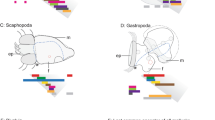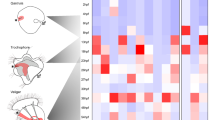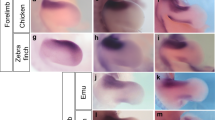Abstract
Comparative analyses of Hox gene expression and regulation in teleost fish and tetrapods support the long-entrenched notion that the distal region of tetrapod limbs, containing the wrist, ankle and digits, is an evolutionary novelty1,2,3,4. Data from fossils support the notion that the unique features of tetrapod limbs were assembled over evolutionary time in the paired fins of fish5. The challenge in linking developmental and palaeontological approaches has been that developmental data for fins and limbs compare only highly derived teleosts and tetrapods; what is lacking are data from extant taxa that retain greater portions of the fin skeletal morphology considered primitive to all bony fish6,7. Here, we report on the expression and function of genes implicated in the origin of the autopod in a basal actinopterygian, Polyodon spathula. Polyodon exhibits a late-phase, inverted collinear expression of 5′ HoxD genes, a pattern of expression long considered a developmental hallmark of the autopod and shown in tetrapods to be controlled by a ‘digit enhancer’ region. These data show that aspects of the development of the autopod are primitive to tetrapods and that the origin of digits entailed the redeployment of ancient patterns of gene activity.
This is a preview of subscription content, access via your institution
Access options
Subscribe to this journal
Receive 51 print issues and online access
$199.00 per year
only $3.90 per issue
Buy this article
- Purchase on Springer Link
- Instant access to full article PDF
Prices may be subject to local taxes which are calculated during checkout




Similar content being viewed by others
References
Sordino, P., van der Hoeven, F. & Duboule, D. Hox gene expression in teleost fins and the origin of vertebrate digits. Nature 375, 678–681 (1995)
Wagner, G. P. & Chiu, C.-H. The tetrapod limb: A hypothesis on its origin. J. Exp. Zool. 291, 226–240 (2001)
Spitz, F., Gonzalez, F. & Duboule, D. A global control region defines a chromosomal regulatory landscape containing the HoxD cluster. Cell 113, 405–417 (2003)
Shubin, N., Tabin, C. & Carroll, S. Fossils, genes, and the evolution of animal limbs. Nature 388, 639–648 (1997)
Shubin, N. H., Daeschler, E. B. & Jenkins, F. A. The pectoral fin of Tiktaalik roseae and the origin of the tetrapod limb. Nature 440, 747–749 (2006)
Davis, M. C., Shubin, N. H. & Force, A. Pectoral fin and girdle development in the basal actinopterygians Polyodon spathula and Acipenser transmontanus. J. Morphol. 262, 608–628 (2004)
Mabee, P. M. Developmental data and phylogenetic systematics: evolution of the vertebrate limb. Am. Zool. 40, 789–800 (2000)
Dahn, R. D., Davis, M. C., Pappano, W. N. & Shubin, N. H. Sonic hedgehog function in chondrichthyan fins and the evolution of appendage patterning. Nature 445, 311–314 (2007)
Hoffman, L., Miles, J., Avaron, F., Laforest, L. & Akimenko, M.-A. Exogenous retinoic acid induces a stage-specific, transient and progressive extension of Sonic hedgehog expression across the pectoral fin bud of zebrafish. Int. J. Dev. Biol. 46, 949–956 (2002)
Riddle, R. D., Johnson, R. L., Laufer, E. & Tabin, C. Sonic hedgehog mediates the polarizing activity of the ZPA. Cell 75, 1401–1416 (1993)
Charité, J., McFadden, D. G. & Olson, E. N. The bHLH transcription factor dHAND controls Sonic hedgehog expression and establishment of the zone of polarizing activity during limb development. Development 127, 2461–2470 (2000)
Altaba, A. R. Gli proteins encode context-dependent positive and negative functions: implications for development and disease. Development 126, 3205–3216 (1999)
Fernandez-Teran, M. et al. Role of dHAND in the anterior-posterior polarization of the limb bud: Implications for the Sonic hedgehog pathway. Development 127, 2133–2142 (2000)
Yelon, D. et al. The bHLH transcription factor Hand2 plays parallel roles in zebrafish heart and pectoral fin development. Development 127, 2573–2582 (2000)
Litingtung, Y., Dahn, R. D., Li, Y., Fallon, J. F. & Chiang, C. Shh and Gli3 are dispensable for limb skeleton formation but regulate digit number and identity. Nature 418, 979–983 (2002)
Sordino, P. & Duboule, D. A molecular approach to the evolution of vertebrate paired appendages. Trends Ecol. Evol. 11, 114–119 (1996)
Metscher, B. D. et al. Expression of Hoxa-11 and Hoxa-13 in the pectoral fin of a basal ray-finned fish, Polyodon spathula: implications for the origin of tetrapod limbs. Evol. Dev. 7, 186–195 (2005)
Tarchini, B. & Duboule, D. Control of Hoxd genes’ collinearity during early limb development. Dev. Cell 10, 93–103 (2006)
Frietas, R., Zhang, G. & Cohn, M. J. Evidence that mechanisms of fin development evolved in the midline of early vertebrates. Nature 442, 1033–1037 (2006)
Ros, M. A. et al. The chick oligozeugodactyly (ozd) mutant lacks sonic hedgehog function in the limb. Development 130, 527–537 (2003)
Prince, V. E., Joly, L., Ekker, M. & Ho, R. K. Zebrafish hox genes: genomic organization and modified colinear expression patterns in the trunk. Development 125, 407–420 (1998)
Bemis, W. E. & Grande, L. Early development of the actinopterygian head. I. External development and staging of the paddlefish Polyodon spathula. J. Morphol. 213, 47–83 (1992)
Acknowledgements
We thank the Kahrs family and Osage Catfisheries for their continuing support of our research. This project is dedicated to the memory of John and Jim Kahrs, without whom Polyodon would not have been available for this research. M.C.D is supported by the University of Chicago, N.H.S. is supported by grants from the University of Chicago, the NSF and the NIH (NRSA to R.D.D.).
Sequences for Polyodon Shh, Ptc1, dHAND, Gli3, Hoxa11, Hoxa13, Hoxd11, Hoxd12, and Hoxd13 are deposited in Genbank with accession numbers: Shh (1,006 bp, EF100659), Ptc1 (1,253 bp, EF527815), dHAND (278 bp, EF527816), Gli3 (1,045 bp, EF534083), Hoxd11 (486 bp, EF527819), Hoxd12 (420 bp, EF527820), and Hoxd13 (863 bp, EF527821), Hoxa11 (660 bp, EF527817), Hoxa13 (833 bp, EF52718).
Author information
Authors and Affiliations
Corresponding author
Ethics declarations
Competing interests
Reprints and permissions information is available at www.nature.com/reprints. The authors declare no competing financial interests.
Supplementary information
Supplementary Figure
This file contains Supplementary Figure 1 with Legend. (PDF 9134 kb)
Rights and permissions
About this article
Cite this article
Davis, M., Dahn, R. & Shubin, N. An autopodial-like pattern of Hox expression in the fins of a basal actinopterygian fish. Nature 447, 473–476 (2007). https://doi.org/10.1038/nature05838
Received:
Accepted:
Issue Date:
DOI: https://doi.org/10.1038/nature05838
This article is cited by
-
A median fin derived from the lateral plate mesoderm and the origin of paired fins
Nature (2023)
-
Spatial regulation by multiple Gremlin1 enhancers provides digit development with cis-regulatory robustness and evolutionary plasticity
Nature Communications (2021)
-
Hoxd13/Bmp2-mediated mechanism involved in zebrafish finfold design
Scientific Reports (2021)
-
Expression of meis and hoxa11 in dipnoan and teleost fins provides new insights into the evolution of vertebrate appendages
EvoDevo (2018)
-
The evolutionary origin of digit patterning
EvoDevo (2017)
Comments
By submitting a comment you agree to abide by our Terms and Community Guidelines. If you find something abusive or that does not comply with our terms or guidelines please flag it as inappropriate.



